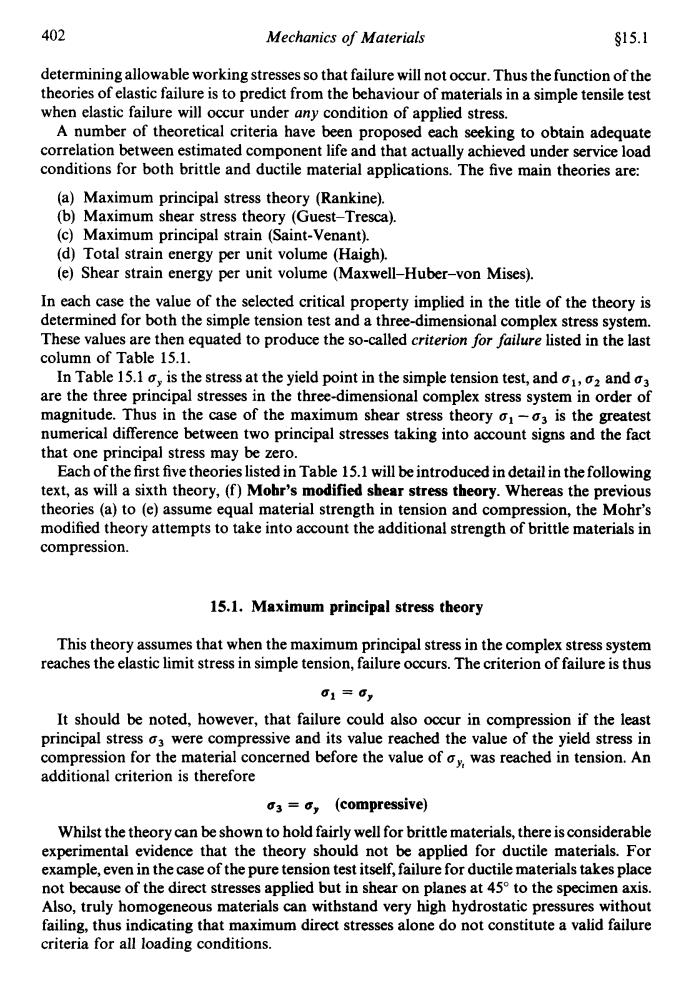正在加载图片...

402 Mechanics of Materials §15.1 determining allowable working stresses so that failure will not occur.Thus the function of the theories of elastic failure is to predict from the behaviour of materials in a simple tensile test when elastic failure will occur under any condition of applied stress. A number of theoretical criteria have been proposed each seeking to obtain adequate correlation between estimated component life and that actually achieved under service load conditions for both brittle and ductile material applications.The five main theories are: (a)Maximum principal stress theory (Rankine). (b)Maximum shear stress theory (Guest-Tresca). (c)Maximum principal strain (Saint-Venant). (d)Total strain energy per unit volume(Haigh). (e)Shear strain energy per unit volume (Maxwell-Huber-von Mises). In each case the value of the selected critical property implied in the title of the theory is determined for both the simple tension test and a three-dimensional complex stress system. These values are then equated to produce the so-called criterion for failure listed in the last column of Table 15.1. In Table 15.1 o,is the stress at the yield point in the simple tension test,and 2 and 3 are the three principal stresses in the three-dimensional complex stress system in order of magnitude.Thus in the case of the maximum shear stress theory o-3 is the greatest numerical difference between two principal stresses taking into account signs and the fact that one principal stress may be zero. Each of the first five theories listed in Table 15.1 will be introduced in detail in the following text,as will a sixth theory,(f)Mohr's modified shear stress theory.Whereas the previous theories (a)to (e)assume equal material strength in tension and compression,the Mohr's modified theory attempts to take into account the additional strength of brittle materials in compression. 15.1.Maximum principal stress theory This theory assumes that when the maximum principal stress in the complex stress system reaches the elastic limit stress in simple tension,failure occurs.The criterion of failure is thus 01=0y It should be noted,however,that failure could also occur in compression if the least principal stress o3 were compressive and its value reached the value of the yield stress in compression for the material concerned before the value of ay was reached in tension.An additional criterion is therefore 3=o,(compressive) Whilst the theory can be shown to hold fairly well for brittle materials,there is considerable experimental evidence that the theory should not be applied for ductile materials.For example,even in the case of the pure tension test itself,failure for ductile materials takes place not because of the direct stresses applied but in shear on planes at 45 to the specimen axis. Also,truly homogeneous materials can withstand very high hydrostatic pressures without failing,thus indicating that maximum direct stresses alone do not constitute a valid failure criteria for all loading conditions.402 Mechanics of Materials $15.1 determining allowable working stresses so that failure will not occur. Thus the function of the theories of elastic failure is to predict from the behaviour of materials in a simple tensile test when elastic failure will occur under any condition of applied stress. A number of theoretical criteria have been proposed each seeking to obtain adequate correlation between estimated component life and that actually achieved under service load conditions for both brittle and ductile material applications. The five main theories are: (a) Maximum principal stress theory (Rankine). (b) Maximum shear stress theory (Guest-Tresca). (c) Maximum principal strain (Saint-Venant). (d) Total strain energy per unit volume (Haigh). (e) Shear strain energy per unit volume (Maxwell-Huber-von Mises). In each case the value of the selected critical property implied in the title of the theory is determined for both the simple tension test and a three-dimensional complex stress system. These values are then equated to produce the so-called criterion for failure listed in the last column of Table 15.1. In Table 15.1 u,, is the stress at the yield point in the simple tension test, and ul, u2 and u3 are the three principal stresses in the three-dimensional complex stress system in order of magnitude. Thus in the case of the maximum shear stress theory u1 -u3 is the greatest numerical difference between two principal stresses taking into account signs and the fact that one principal stress may be zero. Each of the first five theories listed in Table 15.1 will be introduced in detail in the following text, as will a sixth theory, (f) Mobr's modified sbear stress theory. Whereas the previous theories (a) to (e) assume equal material strength in tension and compression, the Mohr's modified theory attempts to take into account the additional strength of brittle materials in compression. 15.1. Maximum principal stress theory This theory assumes that when the maximum principal stress in the complex stress system reaches the elastic limit stress in simple tension, failure occurs. The criterion of failure is thus Ul = by It should be noted, however, that failure could also occur in compression if the least principal stress u3 were compressive and its value reached the value of the yield stress in compression for the material concerned before the value of u,,, was reached in tension. An additional criterion is therefore uj = up (compressive) Whilst the theory can be shown to hold fairly well for brittle materials, there is considerable experimental evidence that the theory should not be applied for ductile materials. For example, even in the case of the pure tension test itself, failure for ductile materials takes place not because of the direct stresses applied but in shear on planes at 45" to the specimen axis. Also, truly homogeneous materials can withstand very high hydrostatic pressures without failing, thus indicating that maximum direct stresses alone do not constitute a valid failure criteria for all loading conditions